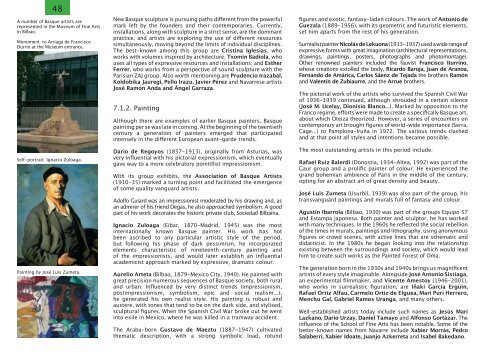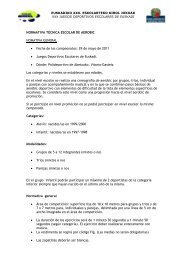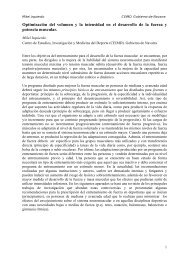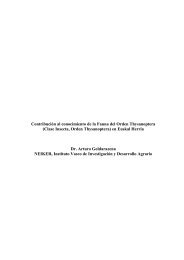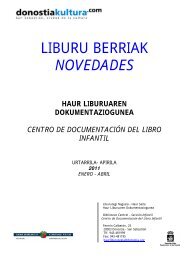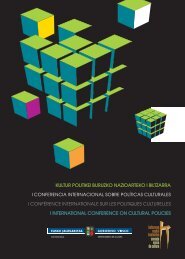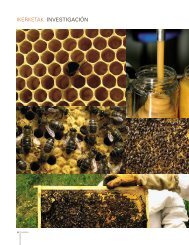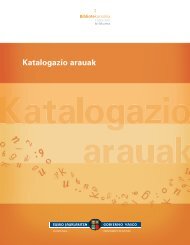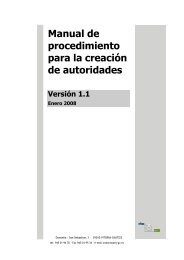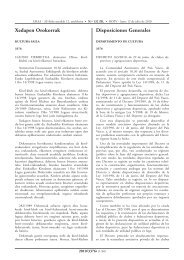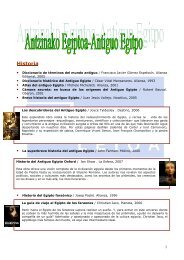The Basque Country (pdf, 4,3Mb) - Kultura Saila - Euskadi.net
The Basque Country (pdf, 4,3Mb) - Kultura Saila - Euskadi.net
The Basque Country (pdf, 4,3Mb) - Kultura Saila - Euskadi.net
Create successful ePaper yourself
Turn your PDF publications into a flip-book with our unique Google optimized e-Paper software.
48<br />
A number of <strong>Basque</strong> artists are<br />
represented in the Museum of Fine Arts<br />
in Bilbao.<br />
Monument to Arriaga de Francisco<br />
Durrio at the Museum entrance.<br />
Self-portrait. Ignacio Zuloaga.<br />
Painting by José Luis Zumeta.<br />
New <strong>Basque</strong> sculpture is pursuing paths different from the powerful<br />
mark left by the founders and their contemporaries. Currently,<br />
installations, along with sculpture in a strict sense, are the dominant<br />
practice, and artists are exploring the use of different resources<br />
simultaneously, moving beyond the limits of individual disciplines.<br />
<strong>The</strong> best-known among this group are Cristina Iglesias, who<br />
works with volumes inspired by architecture; Txomin Badiola, who<br />
uses all types of expressive resources and installations; and Esther<br />
Ferrer, who works from a perspective of sound sculpture with the<br />
Parisian ZAJ group. Also worth mentioning are Prudencio Irazabal,<br />
Koldobika Jauregi, Pello Irazu, Javier Pérez and Navarrese artists<br />
José Ramón Anda and Ángel Garraza.<br />
7.1.2. Painting<br />
Although there are examples of earlier <strong>Basque</strong> painters, <strong>Basque</strong><br />
painting per se was late in coming. At the beginning of the twentieth<br />
century a generation of painters emerged that participated<br />
intensely in the different European avant-garde trends.<br />
Darío de Regoyos (1857-1913), originally from Asturias, was<br />
very influential with his pictorial expressionism, which eventually<br />
gave way to a more celebratory pointillist impressionism.<br />
With its group exhibits, the Association of <strong>Basque</strong> Artists<br />
(1910-35) marked a turning point and facilitated the emergence<br />
of some quality vanguard artists.<br />
Adolfo Guiard was an impressionist moderated by his drawing and, as<br />
an admirer of his friend Degas, he also approached symbolism. A good<br />
part of his work decorates the historic private club, Sociedad Bilbaína.<br />
Ignacio Zuloaga (Eibar, 1870-Madrid, 1945) was the most<br />
internationally known <strong>Basque</strong> painter. His work has not<br />
been ascribed to any particular artistic style of the period,<br />
but following his phase of dark pessimism, he incorporated<br />
elements characteristic of ni<strong>net</strong>eenth-century painting and<br />
of the impressionists, and would later establish an influential<br />
academicist approach marked by expressive, dramatic colour.<br />
Aurelio Arteta (Bilbao, 1879-Mexico City, 1940). He painted with<br />
great precision numerous sequences of <strong>Basque</strong> society, both rural<br />
and urban. Influenced by very distinct trends (impressionism,<br />
postimpressionism, symbolism, epic and social realism...),<br />
he generated his own realist style. His painting is robust and<br />
austere, with tones that tend to be on the dark side, and stylised,<br />
sculptural figures. When the Spanish Civil War broke out he went<br />
into exile in Mexico, where he was killed in a tramway accident.<br />
<strong>The</strong> Araba-born Gustavo de Maeztu (1887-1947) cultivated<br />
thematic description, with a strong symbolic load, rotund<br />
figures and exotic, fantasy-laden colours. <strong>The</strong> work of Antonio de<br />
Guezala (1889-1956), with its geometric and futuristic elements,<br />
set him aparts from the rest of his generation.<br />
Surrealist painter Nicolás de Lekuona (1913-1937) used a wide range of<br />
expressive forms with great imagination (architectural representations,<br />
drawings, paintings, posters, photographs and photomontage).<br />
Other renowned painters included the fauvist Francisco Iturrino,<br />
whose creations extolled the body, Ricardo Baroja, Juan de Aranoa,<br />
Fernando de Amárica, Carlos Sáenz de Tejada the brothers Ramón<br />
and Valentín de Zubiaurre, and the Arrue brothers.<br />
<strong>The</strong> pictorial work of the artists who survived the Spanish Civil War<br />
of 1936-1939 continued, although shrouded in a certain silence<br />
(José M. Ucelay, Dionisio Blanco...). Marked by opposition to the<br />
Franco regime, efforts were made to create a specifically <strong>Basque</strong> art,<br />
about which Oteiza theorized. However, a series of encounters on<br />
contemporary art brought figures of world-wide importance (Serra,<br />
Cage...) to Pamplona-Iruña in 1972. <strong>The</strong> various trends clashed<br />
and at that point all styles and intentions became possible.<br />
<strong>The</strong> most outstanding artists in this period include:<br />
Rafael Ruiz Balerdi (Donostia, 1934-Altea, 1992) was part of the<br />
Gaur group and a prolific painter of colour: He experienced the<br />
grand bohemian ambience of Paris in the middle of the century,<br />
opting for an abstract art of great density and beauty.<br />
José Luis Zumeta (Usurbil, 1939) was also part of the group, his<br />
transvanguard paintings and murals full of fantasy and colour.<br />
Agustin Ibarrola (Bilbao, 1930) was part of the groups Equipo 57<br />
and Estampa japonesa. Both painter and sculptor, he has worked<br />
with many techniques. In the 1960s he reflected the social rebellion<br />
of the times in murals, paintings and lithography, using anonymous<br />
figures or crowd scenes, with active lines that are schematic and<br />
didacticist. In the 1980s he began looking into the relationship<br />
existing between the surroundings and society, which would lead<br />
him to create such works as the Painted Forest of Oma.<br />
<strong>The</strong> generation born in the 1930s and 1940s brings us magnificent<br />
artists of every style imaginable. Alongside José Antonio Sistiaga,<br />
an experimental filmmaker, and Vicente Amestoy (1946-2001),<br />
who works in surrealistic figuration, are Iñaki García Ergüín,<br />
Rafael Ortiz Alfau, Carmelo Ortiz de Elguea, Mari Puri Herrero,<br />
Menchu Gal, Gabriel Ramos Uranga, and many others.<br />
Well-established artists today include such names as Jesús Mari<br />
Lazkano, Darío Urzay, Daniel Tamayo and Alfonso Gortázar. <strong>The</strong><br />
influence of the School of Fine Arts has been notable. Some of the<br />
better-known names from Navarre include Xabier Morrás, Pedro<br />
Salaberri, Xabier Idoate, Juanjo Azkerreta and Isabel Bakedano.


